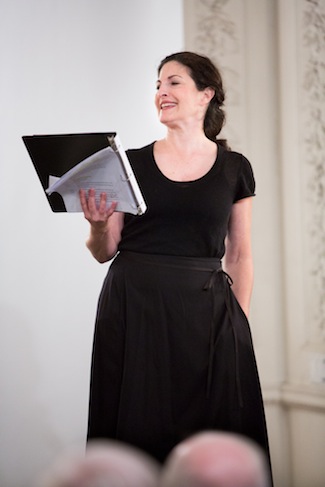Theater Review: Israeli Stage Brings “The Whore From Ohio” to Boston
“The Whore From Ohio” is a provocative reminder that the same creature that is born to eat, drink, copulate, rot, and die is also a creature that dreams, tells stories, contemplates its own existence, and attends the theater.
The Whore From Ohio by Hanoch Levin, translated from the Hebrew by Sandra Silverston. Staged reading directed by Guy Ben-Aharon. Presented by Israeli Stage. At the Goethe Institut-Boston, November 10.

Sarah Newhouse in the staged reading, via Israeli Stage, of “The Whore From Ohio.” Photo: Alena Kuzub.
By Ian Thal
Israeli Stage marked its third birthday and its fourth season with the New England premiere of Hanoch Levin’s The Whore From Ohio. Levin may seem to be an unusual choice: he died of lung cancer in 1999 while most of the repertoire presented by Israeli Stage has been by still living playwrights (the other exception has been that of Anat Gov, whose death in December 2012 was far more recent.)
Born in 1943, Levin was part of a generation of Israeli writers who helped create a distinctly homegrown drama. In fact, he was a founding member of the Israeli Playwrights’ Union. (In a 2012 Fuse interview director Guy Ben-Aharon mentions that Israeli theater came out of the repertory theaters of Russia — so the development of a distinctive Israeli repertoire was significant.) His frequently controversial work, ran the gamut (or more properly, the aleph-bet) of political satire, blasphemy, and vulgarity, resulting in both prestigious literary awards and calls for censorship from religious political parties. After Levin’s death the Cameri Theatre in Tel Aviv, one of Israel’s oldest theaters, where he had long been a playwright-in-residence, founded the Israel Institute for Drama in his name.
The Whore from Ohio, which premiered at the Cameri in 1997, opens as Hoibitter (Ken Baltin), a beggar celebrating his seventieth birthday, attempts to solicit the services of a prostitute named Brontsatski (Sarah Newhouse). Despite his claim that he has been saving up for three years for the evening’s coupling, he still attempts to haggle a significant discount from the stated price of 100 shekels. Theatergoers might hear echoes of a Brechtian approach, in which the audience is reminded that the poor can scarcely afford bourgeois morality so long as they live in poverty – but Levin’s concerns are as much existential as they are materialist.
Once a price is finally settled upon, Hoibitter is repelled by the grim reality of fleshly existence: the dirty alleyway where the copulation is to occur, the smells, the way that sex-as-commodity strips the act of eroticism. That, and perhaps his declining health, renders him impotent. Hoibitter wants a refund. Brontsatski refuses, noting that she had made every effort to fulfill her end of the contract. At that point, his son, Hoimar (Nael Nacer), also a beggar, arrives on the scene, angry that his father has spent his savings. Finally, a compromise is agreed upon: the son is to receive the father’s birthday present.
No one receives pleasure from the exchange. In contemporary American theater, as in most of pop-culture, vulgar dialogue, profane comparisons, and obscene actions are mined for either easy shock-value or titillation. Levin uses the proximity of love and lust to explore, via metaphor and allegory, the relationship between the sublime and the vulgar.
Baltin, in the talkback that followed the reading, noted the existential themes of the play. A casual student of Jean-Paul Sartre’s Being and Nothingness, would have little problem seeing Sartre’s transcendental ego in Hoibitter: not simply disturbed by the fact that other egos exist, but that they are truly incarnate: they hunger, they lust, they have blemishes, scars, exude odors, and excrete waste.
Hoimar, too, is also disgusted by bodily reality and idly wishes that his father would find religion and spend his final years in shul. He also wonders if Hoibitter has secretly amassed a small fortune that he might inherit, which leads to a fantasy that his father might be a wealthy industrialist living incognito on the streets, with factories and other concerns in the far-away land of Ohio. Hoibitter, likewise, nurses a grandiose fantasy about his son: that he is secretly a movie star who will rescue him from a beggar’s life.
In both Hoibitter’s and Hoimar’s fantasies the titular Whore lives in “a whorehouse in Ohio twice as big as our country.” The image is inspired by one of the opulent palaces in The One Thousand And One Nights, so vast as to contain their own forests and coastal waters, their boudoirs and halls protected by dutiful “shvartzers” (a Yiddish word for black people; opinions differ as to whether it is a slur or merely descriptive). The Whore from Ohio is an idealized concubine who consorts with movie stars, industrialists, and weary schnorrers. She is always clean, always well-rested, always surrounded by luxury.
Even Hoibitter’s erotic fantasies are structured like Scheherazade’s episodic tales, with one libidinal cathexis nested inside another, each climax put off by an interruption.
Brontsatski, though a street walker, balks at any notion that she might be anyone’s perfect prostitute. She refuses to be classified as the mother-whore, the angel-whore, or the whore-with-a-heart-of-gold. She does not offer her story as to how she came to be in her circumstances and does not demand anyone feel sorry for her – she only asks that her economic realities be acknowledged. The realities of flesh and commerce also disgust her. At one point she confesses that “my ass is in a race against time” – and, as all members of capitalist society know, time is money. Some day, she dreams, a rich American tourist will fall in love with her and take her to the exotic city of Los Angeles.
Hoibitter is troubled that his grown son sees him as a foolish beggar and not as the omnipotent God of Hoimar’s childhood. Hoimar is troubled that his conception was not a matter of fate but simply a drunken, accidental collision of sperm and egg and that this is the only legacy he can pass on to his own child.
While many of Levin’s existential themes are assessable to western theater audiences weaned on Samuel Beckett, there is also a distinctly Israeli context. The beggars and whore conduct their business in shekels in a coastal city beset by American tourists, much like Tel Aviv. However, Hoibitter and Hoimar are but two generations of a dynasty of beggars, schnorrers from the old country, living on the margins of Israeli society because of their inability to adapt to either the socialist society built by the Labor Zionists or the bourgeois society of the Revisionist Zionists. Even their occasional use of Yiddish signifies their reluctance to assimilate. The pair’s description of themselves as part of a “dynasty” evokes a parallel between the play’s familial line of schnorrers and the rabbinical dynasties of the Haredim.
The Haredim (frequently referred to in the mainstream press as “ultra-Orthodox” – though many Haredim regard the term as a pejorative) are often perceived as schnorrers by secular Israelis. Most Haredi men avoid the military service (mandatory for other Jewish citizens) and few participate in the workforce. That leaves most Israeli Haredi families heavily dependent on welfare – they embrace the privileges of Israeli citizenship while rejecting its responsibilities. Haredim living in the Diaspora, by contrast, generally do participate in the workforce.

Nael Nacer and Ken Baltin in the staged reading of, via Israeli Stage, of “The Whore From Ohio.” Photo: Alena Kuzub.
While more Israeli Haredim work and serve in the IDF than they did when Levin wrote the play, most still exempt themselves through yeshiva studies. Likewise, the traditional schnorrer is understood as distinct from the customary victim of misfortune who is in need of charity. The schnorrer of yore takes pride in his craft and believes himself entitled to handouts, even if he has no need. (Levin ironically underlines the play’s analogy of schnorrer and Haredi when Hoimar compares the daavening movement of Jewish prayer with the pelvic thrusting of a man having sex standing up.)
Despite the short rehearsal period for staged readings allowed by Actors’ Equity contracts, director Ben-Aharon found ways to block (effectively) the physical comedy the play demands, whether it be failed copulations or Brontsatski’s elaborate ruse when she visits Hoibitter in his apartment in a later scene.
As Hoibitter, Baltin gives equal weight to the character’s existential tragedy and vulgar comedy, while a more restrained Nael Nacer plays Hoimar as a foil who in a few decades is likely to become a worthy successor to his father. (During the evening’s talk-back, both actors noted some parallel themes when they were paired as father and son in last year’s New Rep production of The Kite Runner.) In contrast, Sarah Newhouse is a nimble trickster in her portrayal of Brontsatski: damaged in her own way, she is too cagey to reveal her injuries to the men who hire her, but wily enough to occasionally indulge the men in their fantasies when it furthers her economic survival.
The Whore From Ohio is a reminder that the same creature that is born to eat, drink, copulate, rot, and die is also a creature that dreams, tells stories, contemplates its own existence, and attends the theater.
Ian Thal is a performer and theatre educator specializing in mime, commedia dell’arte, and puppetry, and has been known to act on Boston area stages from time to time, sometimes with Teatro delle Maschere, and on occasion served on productions as a puppetry choreographer or dramaturg. He has performed his one-man show, Arlecchino Am Ravenous, in numerous venues in Massachusetts and Rhode Island, and is currently working on his second full length play; his first, though as-of-yet unproduced, was picketed by a Hamas supporter during a staged reading. Formally the community editor at The Jewish Advocate, he blogs irregularly at the unimaginatively entitled From The Journals of Ian Thal, and writes the “Nothing But Trouble” column for The Clyde Fitch Report.
Tagged: Goethe Institut-Boston, Guy Ben-Aharon, Hanoch Levin, Israeli Stage
